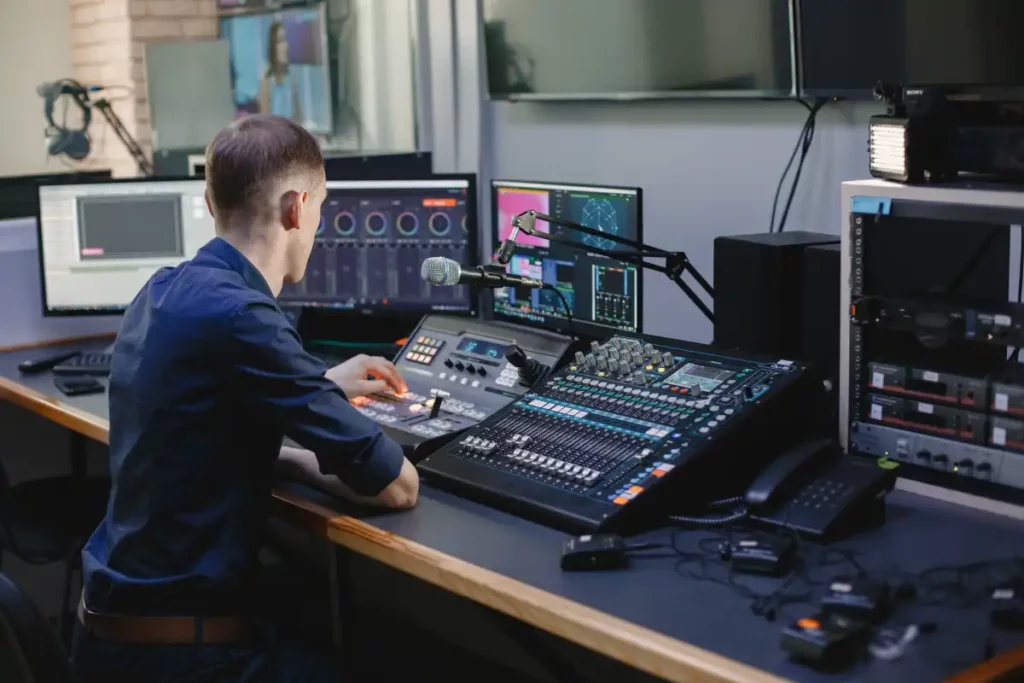Setup Your AV Broadcast With this Detailed Guide!
The merging of AV Broadcast and audio visual productions has changed how material is produced and distributed in today’s media. Comprehending the subtleties of these technologies is crucial for both content makers and broadcasters. This blog examines the complex link between audio visual broadcasting and AV productions and also examines their different goals, approaches, and effects on contemporary media consumption. This blog provides helpful insights into utilizing AV technology for captivating and immersive content delivery, from assessing broadcasting requirements to streamlining AV broadcast configurations.
Key Takeaways
- Understanding how AV technology works in broadcasting to ensure engaging media experiences.
- Broadcasters can amplify their general content to a wider audience just with the help of AV broadcasting.
- Manage your AV broadcasting setup with a step-by-step guide.
- Explore how modern broadcasting compares to traditional modes.
Understanding AV Technology in Broadcasting
Having a good understanding of AV technology in broadcasting means knowing how audio visual innovations are incorporated into media like TV and radio. Broadcast uses equipment like AV broadcast cameras, professional sound systems, and other such audio video broadcasting equipment to enhance the content quality and experience. This technology is dedicated to providing its audience with an amazing listening and viewing experience through sharp audio and visuals.
You must remember that an AV broadcast is not just about TV and radio. It also includes streaming platforms like Netflix, Amazon Prime, and many more. Av tech has been a great help for broadcasters helping them craft engaging and fun content to present on these media platforms. The audience nowadays has become very choosy and hence, it’s important to offer what they want and through the right platform. Will it be fun to attend a concert on the radio? No right? That is exactly what we are talking about.
How Broadcast And AV Are Converging?
The convergence of broadcast and audio visual technology is changing how media is shared. Traditional broadcasting methods are blending with advanced AV tools. Broadcasters now use things like high-quality cameras, immersive sound systems, and instant editing software to make better content. This mix lets them create more exciting shows that match what today’s viewers want – something interactive and immersive.
Also, AV broadcasting solutions help content spread easily across different platforms like TV, online streaming, and mobile apps. This means broadcasters can reach more people and keep up with how people consume media. By using AV tech solutions, broadcasters improve the quality, flexibility, and accessibility of their content, bringing in a new era of innovation in the broadcasting world.
Simply Your Audio Video Broadcast Setup With This Step-By-Step Guide!
An Audio Video Broadcast system’s setup may be simple and effective with the correct strategy, despite its intimidating appearance. To make things easier, follow these steps:
Step 1: Analyze The Broadcasting Requirements Of The User
Understanding the user’s specific needs and goals is crucial before starting the setup process. This involves assessing factors such as audience demographics, content type, and distribution channels.
Step 2: Camera Installations
Install high-quality AV broadcast cameras strategically to capture clear and engaging visuals. Consider factors like angles, lighting, and coverage area to ensure optimal video quality.
Step 3: Audio Setup
Set up professional audio equipment to capture clear and crisp sound. This may include microphones, mixers, and sound processors to enhance audio quality.
Step 4: Video Processing
Utilize video processing equipment to refine and enhance the video feed. This may involve color correction, image stabilization, and other adjustments to improve visual quality.
Step 5: Graphics And Overlays
Incorporate graphics and overlays to enhance the broadcast’s visual appeal. This can include logos, text overlays, and lower thirds to provide additional information or branding.
Step 6: Content Storage And Management
Implement a system for storing and managing content efficiently. This may involve using digital storage solutions and content management software to organize and access media assets.
Step 7: Install an AV Broadcast Software
Install specialized AV broadcast software to facilitate seamless control and management of the broadcasting process. This software may include features for scheduling, live streaming, and content editing.
Step 8: Ensure Connectivity
Ensure reliable connectivity between all AV broadcasting equipment and systems. This includes establishing network connections, configuring routers, and testing data transfer speeds.
Step 9: Testing And Training
Conduct thorough testing of the entire AV broadcast setup to identify and address any issues. Provide training to personnel on operating the equipment and software effectively.
Step 10: It’s Time To Go Live!
Once everything is set up and tested, it’s time to launch the broadcast! Ensure all broadcasting systems are running smoothly and monitor the broadcast for any potential issues during the live event.
What is the Difference Between Audio Visual Broadcasting and AV Productions?
Audio visual Broadcasting and AV productions are both amazing media distribution channels. However, they both have very distinct purposes. These technologies not only serve different purposes but have different methodologies all together. Let’s have a detailed look at how broadcasting an AV production functions.
AV Broadcast media majorly includes distribution channels like television and radio. This way you can spear the content to a wider audience over airwaves or through cables/satellite networks. You’ll mostly find live or recorded pieces of content in broadcasting that are delivered to the audience at a specific time or scheduled slots catering to a wide range of audiences.
On the other hand, AV Productions offers a much broader range of media formats, including presentations, films, videos, and interactive media. Did you know AV productions also incorporate broadcasting? Hence, it’s a wider concept. This technology is more focused on the user experience by incorporating elements like HD visuals, surround sound, interactive interfaces, and VR.
You might still find both A/V & Broadcast Productions to be similar. Let us clearly help you understand the difference. While both technologies are created for the dissemination of content through audio visual modes, the major difference lies in the target audience. Broadcasting is focused on a larger audience that is patiently waiting for the content. Whereas AV production offers a wider range of formats and uses AV technologies to create an engaging experience for the audience.
AV Design Mastery + Winning Proposals = 10x Productivity!
- Automatic Cable Labeling & Styling
- 100+ Free Proposal Templates
- Upload & Create Floor Plans
- 1.5M Products from 5200 Brands
- AI-powered ‘Search Sense'
- Legally Binding Digital Signatures
Conclusion
The lines separating audio visual broadcasting and AV productions are becoming increasingly hazy as technology advances, providing you with virtually limitless opportunities. Broadcasters may meet the varied tastes of contemporary audiences by elevating the caliber, accessibility, and reach of their programming by embracing the convergence of these technologies. The collaboration between AV broadcast and AV production, whether it be via the use of immersive sound systems to improve the watching experience or the delivery of fascinating images through top-notch cameras, opens up new possibilities for creativity and innovation in the always-changing media environment.
Frequently Asked Questions
The main function of audio-visual broadcasting is to reach a large audience by disseminating material via conventional media like radio and television. However, AV productions use a wider variety of media types and concentrate on utilizing cutting-edge audio-visual technologies to create captivating experiences.
High-definition cameras and immersive sound systems are two examples of AV technology that increases audio and visual quality, leading to better content production in broadcasting and a more engaging viewing experience for consumers.
The smooth control and administration of broadcasting operations, such as scheduling, live streaming, and content editing, is made possible by AV broadcast software. It guarantees effective content distribution across a variety of platforms and aids in streamlining processes.
In order to stay relevant and reach a larger audience, broadcasters must adjust to the changing consumption patterns brought about by the introduction of new media platforms and shifting consumer preferences. Broadcasters may maintain their competitive edge in the ever-changing media environment of today by adopting AV technology and investigating new approaches to content distribution.


